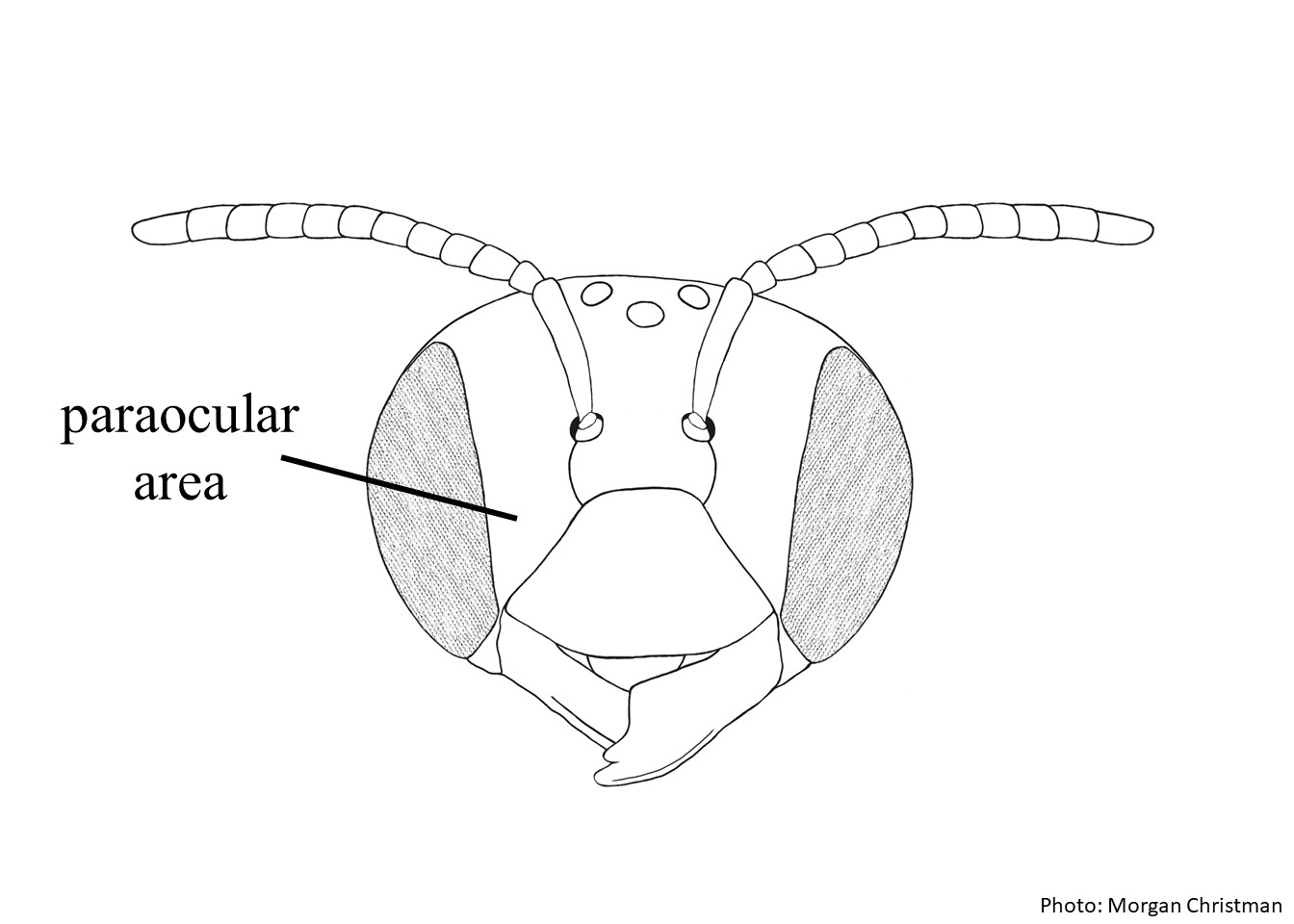Taxonomy
Family: Apidae
Subfamily: Xylocopinae
Tribe: Xylocopini
Genus: Xylocopa
Subgenus: Xylocopsis, Hurd and Moure 1963Hurd and Moure 1963:
Hurd, P.D. and J.S. Moure. 1963. A Classification of the Large Carpenter Bees (Xylocopine) (Hymenoptera: Apoidea). University of California Publications in Entomology (Vol. 29). Berkeley and Los Angeles: University of California Press, 365 pp.
Common name: Carpenter bee
Background
Xylocopa (
Xylocopsis) are small, robust bees, 10-15 mm in body length. They have a dark brown to black
integumentintegument:
a tough, protective outer layer
that is somewhat reflective. They have brown, moderately thick,
pubescencepubescence:
short, fine hair
and their wings are a medium to dark brown with violet reflections (
Hurd and Moure 1963Hurd and Moure 1963:
Hurd, P.D. and J.S. Moure. 1963. A Classification of the Large Carpenter Bees (Xylocopine) (Hymenoptera: Apoidea). University of California Publications in Entomology (Vol. 29). Berkeley and Los Angeles: University of California Press, 365 pp.). They seem to be territorial, attacking invaders, including birds. They have been observed rubbing their
metasomametasoma:
the posterior part of the body
on branches they land on. This is likely to mark their territory with pheromones (
Schlindwein et al. 2003Schlindwein et al. 2003:
Schlindwein, C., Schlumpberger, B., Wittmann, D. and Moure, J.S., 2003. O gecirc;nero Xylocopa Latreille no Rio Grande do Sul, Brasil (Hymenoptera, Anthophoridae). Revista Brasileira de Entomologia , 47 , pp.107-118.).
Diversity
Xylocopa (
Xylocopsis) contains one species,
Xylocopa funesta (
Hurd and Moure 1963Hurd and Moure 1963:
Hurd, P.D. and J.S. Moure. 1963. A Classification of the Large Carpenter Bees (Xylocopine) (Hymenoptera: Apoidea). University of California Publications in Entomology (Vol. 29). Berkeley and Los Angeles: University of California Press, 365 pp.;
Michener 2007Michener 2007:
Michener, C.D. 2007. The Bees of the World (2nd ed.). Johns Hopkins University Press, Baltimore and London, 953 pp.).
Distribution
Xylocopa (
Xylocopsis) occurs from southern Brazil, to Paraguay, and northern Argentina (
Michener 2007Michener 2007:
Michener, C.D. 2007. The Bees of the World (2nd ed.). Johns Hopkins University Press, Baltimore and London, 953 pp.).

Distribution map generated by Discover Life -- click on map for details, credits, and terms of use.
Host associations
Xylocopa (
Xylocopsis) are thought to be generalist pollinators. They have been observed visiting
Passiflora caerulea (Passifloraceae),
Pithecoctenium echinatum (Bignoniaceae),
Styrax leprosus (Styracaceae), and
Tibouchina gracilis (Melastomataceae) (
Schlindwein et al. 2003Schlindwein et al. 2003:
Schlindwein, C., Schlumpberger, B., Wittmann, D. and Moure, J.S., 2003. O gecirc;nero Xylocopa Latreille no Rio Grande do Sul, Brasil (Hymenoptera, Anthophoridae). Revista Brasileira de Entomologia , 47 , pp.107-118.).
May be confused with
Xylocopa (
Xylocopsis) are most similar to
X. (
Dasyxylocopa) but they are larger and more hairy. Males
Xylocopa (
Xylocopsis) can be distinguished by the
bidentatebidentate:
having two teeth
apicalapical:
near or at the apex or end of any structure
margin of
T7T7:
the segments on the top side of the abdomen, often abbreviated when referring to a specific segment to T1, T2, T3, T4, T5, T6, or T7

and females can be distinguished by the raised
paraocular areaparaocular area:
the area extending along the sides of the face parallel to the eye

(
Hurd and Moure 1963Hurd and Moure 1963:
Hurd, P.D. and J.S. Moure. 1963. A Classification of the Large Carpenter Bees (Xylocopine) (Hymenoptera: Apoidea). University of California Publications in Entomology (Vol. 29). Berkeley and Los Angeles: University of California Press, 365 pp.).
Nesting behavior
Xylocopa (
Xylocopsis) are known to nest in dead wood in the humid parts of their native forests (
Schlindwein et al. 2003Schlindwein et al. 2003:
Schlindwein, C., Schlumpberger, B., Wittmann, D. and Moure, J.S., 2003. O gecirc;nero Xylocopa Latreille no Rio Grande do Sul, Brasil (Hymenoptera, Anthophoridae). Revista Brasileira de Entomologia , 47 , pp.107-118.).
Known invasives
There are no known invasives.

 and females can be distinguished by the raised paraocular areaparaocular area:
and females can be distinguished by the raised paraocular areaparaocular area: (Hurd and Moure 1963Hurd and Moure 1963:
(Hurd and Moure 1963Hurd and Moure 1963: